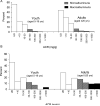Predictive value of albuminuria in American Indian youth with or without type 2 diabetes
- PMID: 20194283
- PMCID: PMC3481836
- DOI: 10.1542/peds.2009-1230
Predictive value of albuminuria in American Indian youth with or without type 2 diabetes
Abstract
Objective: To examine the prognostic significance of elevated albuminuria in youth with type 2 diabetes.
Patients and methods: Cross-sectional and prospective studies were conducted on Pima Indian youth aged 5 to 19 years at baseline who were examined between July 1, 1982, and December 31, 2007. Prevalence and sequential changes in the level of microalbuminuria (30 < or = albumin-to-creatinine ratio [ACR] < 300 mg/g) and macroalbuminuria (ACR > or = 300 mg/g) and incidence of macroalbuminuria were computed according to the presence or absence of type 2 diabetes.
Results: The prevalence of microalbuminuria and macroalbuminuria was 6.5% and 0.6% in the 3856 nondiabetic youth and 18.5% and 2.9% in the 103 youth with diabetes, respectively. One hundred forty-one of 187 (75.4%) nondiabetic youth, but only 1 of 14 (7.1%) diabetic youth with an elevated ACR (> or =30 mg/g) regressed to an undetectable or normal ACR (<30 mg/g) on subsequent examination. In a subset of 2666 youth with a median follow-up of 8.1 years, 36 nondiabetic and 30 diabetic youth with baseline ACRs of <300 mg/g developed macroalbuminuria. For a given ACR, the incidence of macroalbuminuria was 15.9-fold (95% confidence interval: 11.1-22.6) higher in the diabetic than in the nondiabetic youth.
Conclusions: Elevated albuminuria is infrequent and largely transient in nondiabetic youth, but it is relatively frequent and largely persistent in those with diabetes. Microalbuminuria in youth with type 2 diabetes strongly predicts progression to macroalbuminuria, which supports annual screening for albuminuria.
Figures


References
-
- Type 2 diabetes in children and adolescents. American Diabetes Association. Diabetes Care. 2000;23:381–389. - PubMed
-
- Shaw J. Epidemiology of childhood type 2 diabetes and obesity. Pediatr Diabetes. 2007;8(Suppl 9):7–15. - PubMed
-
- Cowell CT, Rogers S, Silink M. First morning urinary albumin concentration is a good predictor of 24-hour urinary albumin excretion in children with type 1 (insulin-dependent) diabetes. Diabetologia. 1986;29:97–99. - PubMed
-
- Gorman D, Sochett E, Daneman D. The natural history of microalbuminuria in adolescents with type 1 diabetes. J Pediatr. 1999;134:333–337. - PubMed
-
- Perkins BA, Krolewski AS. Early nephropathy in type 1 diabetes: a new perspective on who will and who will not progress. Curr Diab Rep. 2005;5:455–463. - PubMed
Publication types
MeSH terms
Substances
Grants and funding
LinkOut - more resources
Full Text Sources
Medical

